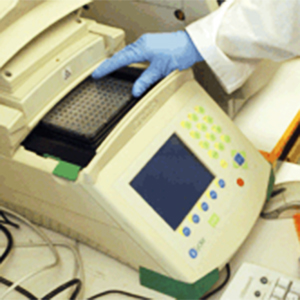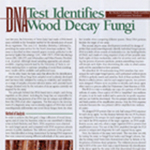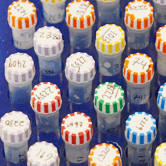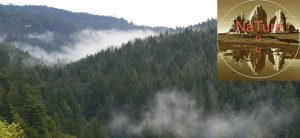A lot depends on when the tree is felled. If a tree is cut in winter, it is possible that the root system will experience an additional year of growth. What happens to the root system depends on many variables, including soil type and presence of other trees of the same species adjacent to the one being felled. If the same species is present and the root systems of neighboring trees are grafted, the roots may be kept alive by trees still standing. Some species, like aspen, will actually sprout new shoots along the root system. Often a stump with roots that are alive will seal the cambium on the stump surface, resulting in a round bump along the entire circumference of the tree right over the cambial area (i.e. just inside the bark).
If a homeowner suspects SOD is affecting their trees, there are a few options to get them tested. SOD kills several oak species and tanoaks, but it is primarily spread via infected California bay laurel leaves. Parties interested in testing for the presence of SOD can contact their local UC Farm Advisor or county Department of Agriculture to find out if they accept symptomatic bay laurel leaves for testing. (Go to Hosts and Symptoms on the California Oak Mortality Task Force [COMTF] website to learn what symptomatic bay leaves look like.)
Another option is to participate in a spring SOD Blitz. These are community-based, volunteer sampling efforts that are organized in cooperation with the Garbelotto lab. Training dates and locations are posted February 1st of each year for the upcoming sampling season at www.sodblitz.org. Training and sampling take just over an hour each and happen on the same scheduled weekend.
For infected oaks, call an arborist. A list of arborists that have attended a SOD training within the last 3 years is available on the Arborists and Applicators page of the COMTF website. NOTE: This list is only intended to be an additional filter for those looking for an arborist. It is not a list of recommended professionals.
Oak testing is routinely done by arborists. It is a rather involved and tedious process that requires a fair amount of finesse and know how as it entails wounding the tree by shaving off the outer layer of bark to collect infected tissue. If you decide to have your oaks tested for SOD, consider going to the Trained Professionals List for arborists that have recently attended an official SOD seminar (Not intended to be a list of recommended professionals, this list does serve as an additional filter when trying to identify arborists that are up-to-date on the latest science-based SOD information.).
Alternatively, a less invasive method of determining the presence or absence of SOD on your property is to sample symptomatic bay leaves (See Hosts and Symptoms for SOD symptoms.). Keep in mind that any infested bay in the general vicinity (typically within 200 ft of an infected oak) may be the inoculum source for infection of your coast live oak. If bay sampling is your preferred method for pathogen detection, you can call your local UC Cooperative Extension office to find out if the California Department of Food and Agriculture is processing leaves from your county and, if so, what the protocol is for sample submissions. In lieu of submitting samples through your county, you can go to www.sodblitz.org to find out when a SOD Blitz will be held in your region (Dates for each year are posted by January 30th. Blitzes typically occur from March to June). Attending a blitz will afford you the opportunity to learn more about SOD, including the latest disease control strategies, during a 1-hour training session. At the end of the session you will be given all sampling materials and instructions for submissions. Blitz participants are free to submit as many leaves as necessary, meaning that you can send in all suspicious leaves from your property as well as from the neighborhood or nearby local parks. All leaves are processed at UC Berkeley and all sampling results are published in a database available at www.sodmap.org or through the free App SODmap mobile.
The lab can, upon request, analyze wood chips at cost ($90 US dollars per sample). Testing would confirm the presence or absence of any known dangerous pathogens.









